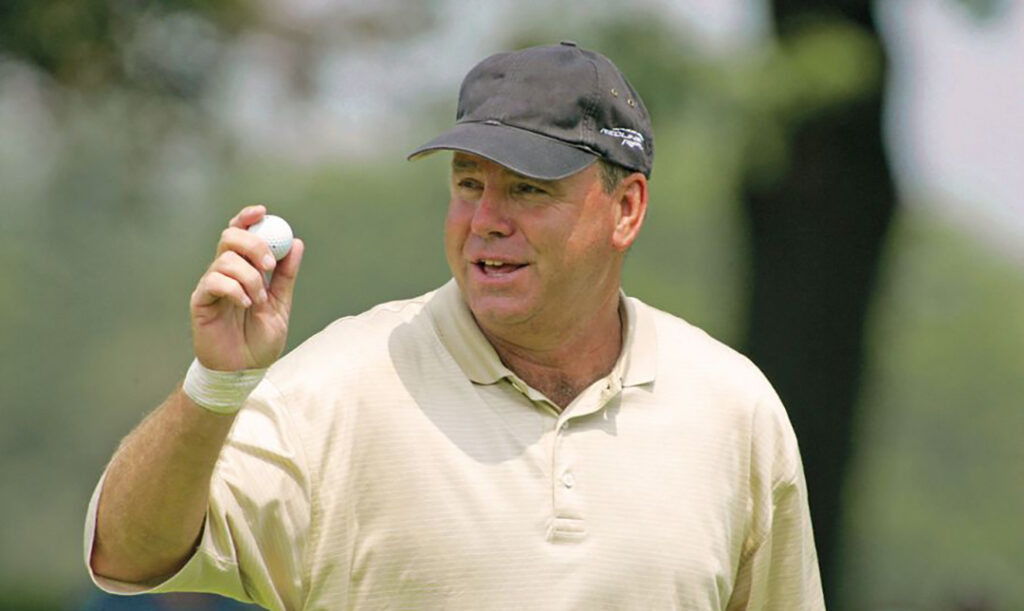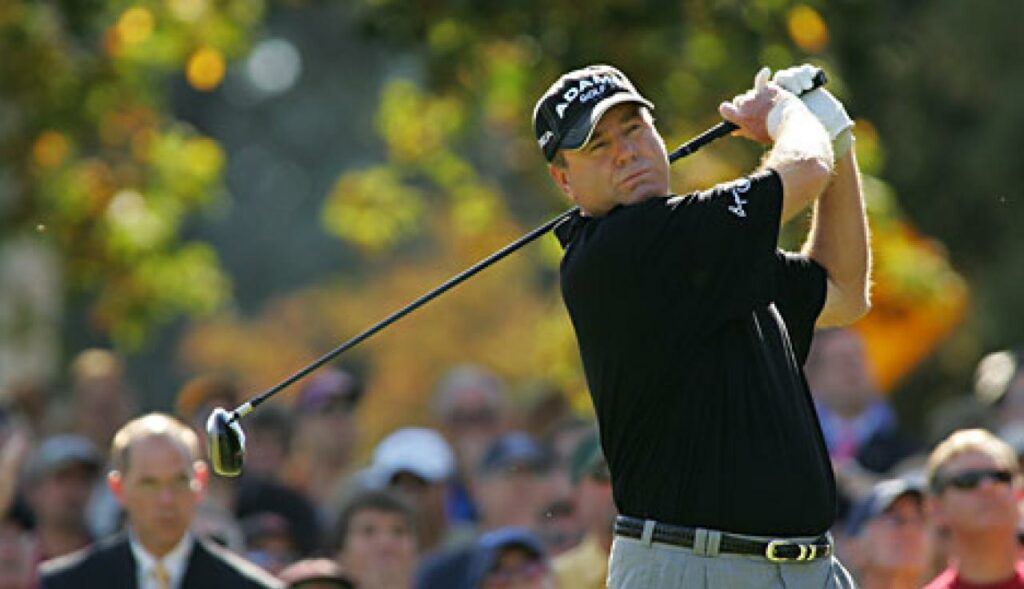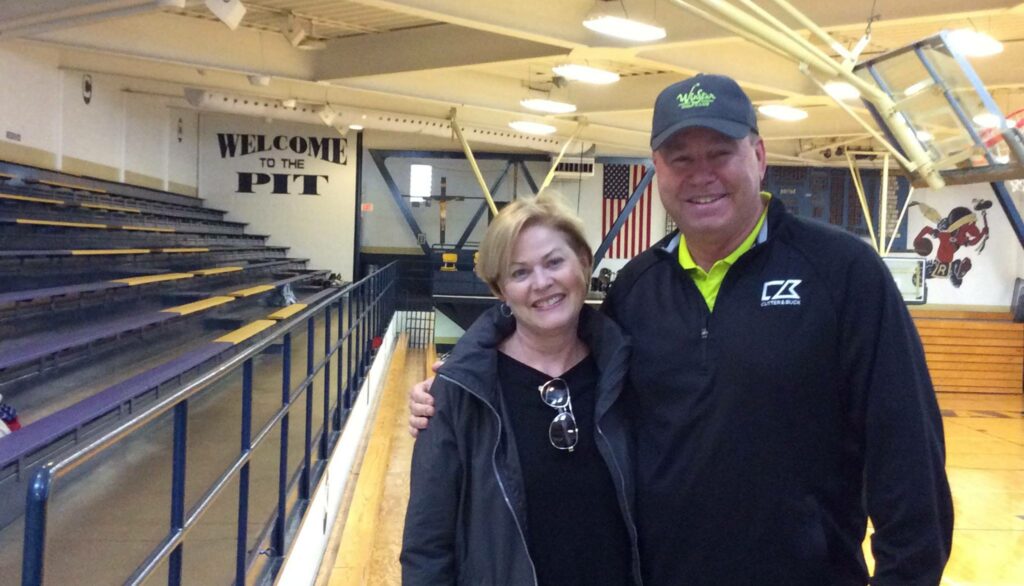Crim: Grandkids and golf continue to keep Weibring active and engaged

FRISCO, Texas — D.A. Weibring was keeping an eye on the Open Championship, wondering whether rain would cancel an afternoon trip to the driving range with a grandson and anticipating the arrival the following day of four grandkids ages 6 and under for a sleepover.
“You want to know what the old guy is up to?” he asked the caller.
Weibring, one of Quincy’s favorite sons, turned 69 in May. It has been six years since he last played on the PGA Tour Champions and 14 years since he captured the last of his 13 professional victories — the Senior Players Championship, his lone major title.
He was hampered by a series of injuries during his final six years on the seniors circuit after winning five times between 2003 and 2008, matching his number of victories in 27 years on the PGA Tour.
He also won three non-tour events — the 1985 Air New Zealand Open, the 1985 Golf Digest Cup and the 1989 Family House Invitational — and played in golf’s four majors a combined 40 times while earning the well-deserved reputation as one of the sport’s most affable players.
For a quarter-century, he hosted a pro-am at Quincy Country Club to raise money for the Adams County Association for Retarded Citizens and enable his hometown to rub shoulders with a host of professional golfers.
He was finally forced into retirement by diffuse idiopathic skeletal hyperostosis, a skeletal disorder that causes ligaments and tendons to harden. For Weibring, it meant glue-like arthritis in the middle of his back, causing pain and stiffness and limiting his mobility, a trifecta of bad medical news for a golfer.
“I had numerous procedures done, including one surgery,” he said. “I can do anything I want to do, but the turning and twisting of the golf swing is the worst. The last three years I kept trying, doing the therapy and the rehab. Finally, the back and spine guy with the (Dallas) Cowboys said, ‘D.A., there’s nothing they can do.’
“I play maybe a couple of rounds a year now. If there’s an outing or an exhibition or a clinic, I can still do stuff like that. I still have the desire. I miss playing the good shots, having the good rounds and good tournaments. But I never wanted to stay out playing (on tour) if I couldn’t compete.”

‘I was prepared when I turned pro and had a good run’
Glancing at his television as the Open Championship began to unfold rekindled memories for Weibring of the first time he played the event in 1985 at Royal St. George’s.
He was one stroke off the lead at the midway point before finishing in a tie for eighth place, three strokes behind winner Sandy Lyle. He was paired with Greg Norman, who would earn the first of two Open titles the following year, in the final round.
“I was struck by how knowledgeable the crowds are there,” Weibring said. “The choices you make around the greens is what golf is all about. Over there it’s golf on the ground and I knew I could play that kind of golf.
“I’m playing a practice round, with who I don’t remember, and he hits a wedge onto the green and gets a lazy clap. I played a little bump, a skidder, not as close as his, but the fans are yelling, ‘Yeah, that’s what we’re talking about.’
“Suddenly I have a gallery following me. They were showing an interest in me. They saw me as a new American player and must have been thinking, ‘Maybe we should put some quid on him.’”
That was Weibring’s best finish in four appearances in the Open, but not his finest in a major.
He finished fourth in the 1986 PGA Championship, four shots behind Bob Tway, who stunned Norman with a hole-out from a greenside bunker on the 72nd hole. It was the year Norman held the 54-hole lead in every major, only to win just once.
The following year he shared the 54-hole lead in the PGA with Mark McCumber before heat and high winds took their toll on the field in the final round. Weibring ended up in a tie for third, a shot behind Larry Nelson, who defeated Lanny Wadkins in a playoff.
That came after he had tied for seventh in the Masters that April, four shots behind Larry Mize, who outlasted Norman and Seve Ballesteros in a sudden-death playoff with a legendary chip-in on the 11th hole.
Weibring went on to finish fourth in the 1988 U.S. Open, two shots behind Curtis Strange. Strange beat Nick Faldo in a playoff for the first of consecutive Open titles.
On the PGA Tour Champions, Weibring had 15 top-10 and eight top-five finishes in the majors, capped by his come-from-behind victory in the 2008 Senior Players Championship when he trailed Nick Price by four shots with 14 holes to play.
The $390,000 payday was the largest of his career.
“I was fortunate,” Weibring said. “I knew when I joined the tour (in 1977) the first five years were going to be critical. I was prepared when I turned pro and had a good run.”

‘I’m just trying to stay healthy so I can watch them grow up’
Today, Weibring is content with working on a few course design and renovation projects with his longtime business partner, Steve Wolfard. Among those are bunker renovations at WeaverRidge in Peoria, Ill., building a practice facility at San Angelo (Texas) State University and renovating Sherrill Park, a public course in Richardson, Texas.
Weibring’s company has been involved in designing, renovating and rescuing more than 100 courses worldwide since he founded it in 1987, including TPC Deere Run in the Quad Cities, which hosts the PGA’s John Deere Classic, and TPC Las Colinas, a home to the AT&T Byron Nelson Golf Classic.
His vision for creating golf courses with visibility, maintainability and playability has always been in demand, although he decided in recent years to cut back on the workload.
“We have downsized our company,” Weibring said. “Steve works out of his house, and I work out of my house. No more (course) management and consulting stuff. I want to have enough things to do that it fulfills my energy, but not too much.
“The phone still rings, which is nice.”
Weibring remains heavily involved with the golf programs at Illinois State University, where he played after graduating from Quincy Catholic Boys in 1971.
A tireless fundraiser, he also oversaw extensive renovations to the University Golf Course in 2000, which the school renamed the Weibring Golf Club at Illinois State University in 2007, and in designing and building a 25-acre practice facility.
“I’ve offered to be a volunteer coach this year,” said Weibring, who is a member of both the ISU and Missouri Valley Conference halls of fame. “In this world of Zoom and Facetime, maybe I can help players focus on the mental side of things and help them be more competitive. Our goal should be a top-60 program.”
However, a good portion of his time is spent being a proud dad and grandpa. Weibring and his wife, Kristy, have three children — Matt, Katey and Allie — who are all grown, married, live nearby and have families of their own.
Matt, a two-time All-American at Georgia Tech, briefly played on the PGA Tour before being sidelined by persistent shoulder and hip problems. Married to Stephanie and the father to three kids, he’s now director of investments for Velocis, a company that buys, refurbishes, manages and resells office buildings and industrial parks.
Katey and her husband, Cory Finazzo, are professional dancers who operate their own business. Allie is a manager with Texas Instruments and her husband, Brett Hopkins, is an engineer working with a movie group. The girls have two children each.
“I’m proud of all of them,” Weibring said.
And, of course, there are the seven grandchildren, the oldest 12 and the youngest having just turned 1. There’s basketball and football games and dance recitals to attend, and golf lessons to teach. Not to mention hosting sleepovers.
“We’re lucky they all live here,” Weibring said. “A lot of families are scattered all over the country. I’m just trying to stay healthy so I can watch them grow up.”
‘I’m grateful for what I accomplished’
Weibring won his final PGA Tour title, the Canon-Greater Hartford Open, in June 1996, two months before Tiger Woods made his professional debut. The game’s television ratings and tournament purses began to skyrocket with Woods as the new face of the tour.
Weibring, for example, earned $270,000 for the victory in Hartford, a hefty sum that represented more than he had won in 15 of his previous 19 seasons on tour. Meanwhile, Xander Schauffele, the winner of this year’s event — now known as the Travelers Championship — pocketed $1.494 million.
The health of the game is now in doubt, however.
The LIV Tour, a rival league headed by Norman and financed by the sovereign wealth fund of Saudi Arabia, has lured some of golf’s recognizable names — some in their prime and others past it — with the promise of no cuts, fewer rounds, a limited schedule and guaranteed millions.
Norman says the goal is to grow the game, but it has been criticized by human rights groups as an example of sportswashing by Saudi Arabia, long known as an oppressive regime.
The eight tournaments scheduled for this year offer $255 million in prize money. The no-cut, 54-hole tournaments feature 48 players drafted into 12 four-man teams with shotgun starts.
The first seven events feature $20 million purses, with an additional $5 million split among the top three teams each week. The final event is a team championship with $30 million going to the top three players and an additional $50 million in team prizes.
“The money is not a concern for them,” Weibring said. “They have a fund that doesn’t end.”
Charl Schwartzel, a South African whose primary claim to fame in two decades on the PGA Tour remains his surprising 2011 Masters victory, pocketed $4.75 million by winning the inaugural LIV event in London — $4 million for the individual title and $750,000 for being part of the winning team.
That nearly matched Weibring’s prize money over 27 years playing PGA Tour events ($4.77 million), although D.A. earned another $8.2 million on the PGA Tour Champions, according to tour statistics.
“It’s great to get more money for the players, but I’m concerned about the LIV deal,” Weibring said. “(Jack) Nicklaus, (Arnold) Palmer and (Gary) Player could have done this back in the day. They were focused on what was good for golf; Greg is focused on Greg.
“He was a fun guy to be around back when I played with him. He was personable. Over time that changed. His focus changed after he had great success on the golf course and good fortune with investments, like Cobra, off the course.”
Weibring applauds the likes of Woods and Rory McIlroy for publicly supporting the PGA Tour and taking a stand against the LIV Tour and the players who have defected.
“I think the greats in our game are standing up and saying, ‘I don’t think so ’ ” he said. “I’m sure they came after (McIlroy) first. I’m proud of Rory. They offered Tiger a ton of money. I’m proud of him because he had never been someone who jumped out (in the center of controversy) before.”
Weibring sees the rival league as particularly attractive to players between the ages of 38 and 45 who believe their best days on the PGA Tour are behind them but are not yet eligible for the PGA Tour Champions. That, however, doesn’t explain the decisions by Brooks Koepka, Bryson DeChambeau and other younger stars who have bolted.
“How do you say you don’t want $5 million, $10 million, $20 million, $30 million?” Weibring said. “Golf can be cruel. You can get an injury. You miss the cut and still have to pay expenses, pay your caddie and make nothing. It’s pure sport.
“Can there be a blend? I think there can be. I think the game is going to stand up and say, ‘You guys can do what you want and have guaranteed money, but you’re not playing in the majors and you’re not playing in the Ryder Cup.’
“Then it’s going to come down to the courts. That would be a shame if a judge decides what happens with our game.”
With his 70th birthday on the horizon, an age he admits “sounds old,” Weibring still yearns for the days a small-town, Midwestern boy was able to compete against some of golf’s greats on the game’s biggest stages.
“I wake up I can’t tell you how often dreaming that I’m still playing,” he said. “I miss it a great deal. I had a chance to play for 40 years and won 13 times. You never feel like you’ve done enough, but I’m grateful for what I accomplished, the people I met and what it has given my family.”
Quincy and the game of golf are equally grateful for D.A. Weibring.
Miss Clipping Out Stories to Save for Later?
Click the Purchase Story button below to order a print of this story. We will print it for you on matte photo paper to keep forever.
